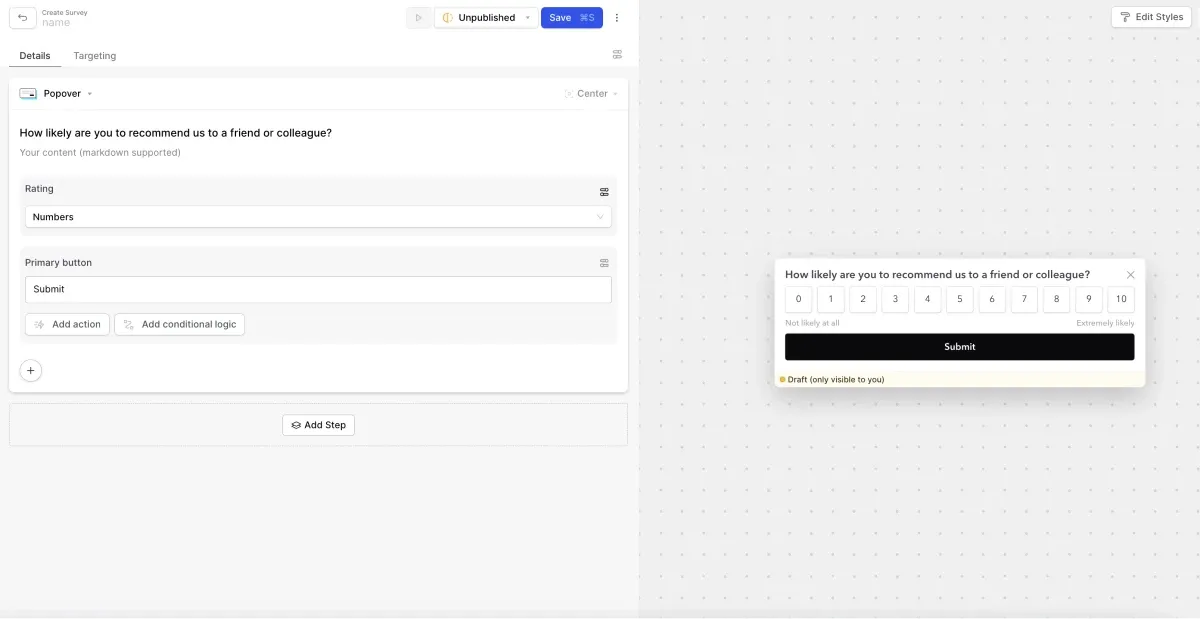We all know that gathering customer feedback, especially through surveys, is a critical component to measuring your user happiness and satisfaction.
In fact, it's really the cornerstone of user feedback collection.
A survey offers the perfect opportunity to gauge your user sentiment and to get accurate, high-quality data — if you do them right.
That’s because not all surveys are the same.
Surveys that are untimely will provide you with unhelpful and inaccurate data, which is worse than no data at all, because you can make decisions with no real basis.
That’s why in-app surveys, when done right, can be your most effective feedback collection tool.
Types of surveys
There’s no shortage of surveys companies can and do run to gather feedback. Here’s a laundry list of a dozen or so popular ones:
- Customer satisfaction surveys (CSAT): used to gauge how satisfied customers are with a company's products or services.
- Net promoter score (NPS) surveys: measure customer loyalty by asking how likely customers are to recommend the product or service to others. Measured on a scale of 1 → 10 usually.
- Product feedback surveys: collect detailed feedback on specific features or functionalities of a software product.
- Usability surveys: evaluate how user-friendly and intuitive the software is for customers.
- Customer effort score (CES) surveys: assess how much effort customers have to put in to use the product or resolve issues.
- Onboarding feedback surveys: gather insights on the effectiveness of the onboarding process for new users.
- Feature request surveys: allow customers to suggest new features or improvements.
- Churn surveys: conducted with customers who have decided to stop using the service to understand their reasons for leaving.
- Market research surveys: used to understand market trends, customer needs, and competitive positioning.
- Employee feedback surveys: collect feedback from employees about their experiences and suggestions related to the product or service they are developing or supporting.
All of these can help you better understand your users and improve your product.
But, to do that you need accurate data, and to get accurate data, you have to run your surveys at the right time, in the right place, for the right user. And that is easier said than done.
There’s several ways you can conduct a survey:
- In-app surveys: Integrated directly into the software application, allowing for real-time feedback from users while they are using the product.
- Email surveys: Sent to customers' email addresses, often with a link to an online survey tool.
- Text surveys: Sent to customers' mobile phones via text message, useful for reaching users on-the-go.
- Telephone surveys: Conducted by calling customers directly, allowing for a more personal interaction and detailed feedback. Often done by your CX/CS team.
- Social media surveys: Posted on social media platforms like LinkedIn, Twitter, or Facebook.
- Video call surveys: Conducted over video calls, this is most useful for detailed discussions or focus group discussions.
For B2B SaaS companies, in-app and email surveys are by far the most common. That’s because they can be automated and don’t usually require a human in the loop, enabling feedback collection at scale.
But why do in-app surveys outperform all of their counterparts?
The world without in-app surveys
Let’s imagine for a minute that you’re not able to run in app surveys in your products.
How do you go about collecting feedback?
You might try after-the-fact email messages or NPS surveys, which are triggered randomly and which don't have great context for your user.
In these formats, they'll find themselves trying to remember what they use you for and how they actually feel about your product. That means that you not only get incomplete data, but also expose yourself to selection bias as you’ll likely end up with strongly opinionated users on both ends of the spectrum choosing to respond, outweighting the real thoughts of your average user in the data.
Or, you might hire a bunch of employees whose only job is to contact customers and solicit feedback. But this is expensive and inefficient.
You can see that it's quite difficult to collect feedback at scale at reasonable cost with these methods.
Why are in-app surveys better?
In-app survey are more contextual, plus they are cheap and easy to run. What makes that true? Because they are more timely and can be more personalized, and are integrated directly in your product, meaning there’s no added dollar cost to run the survey. This is a huge advantage over other survey methods.

Timeliness
In-app surveys are highly timely. As a user goes through onboarding, or when they finish a task, they are prompted to respond to a relevant question in real-time.
They're in that moment.
They have a real sense of how your software is performing, and are primed to give feedback.
One thing to be careful of here is interrupting their workflow. You want to make sure that you have a specific trigger set up to gather the feedback at an opportune time, not when somebody is in the middle of solving a hard problem and you take them out of the flow.
Personalization and segmentation
It's also much easier, and much less creepy, to survey a user based off their product usage in the application, as opposed to after the fact.
Imagine that your user, Bob, has recently interacted with a new feature in your product. As he completes this user flow, you prompt him with a CES survey understand the features ease of use. Bob happily responds given he was just in the flow.
Now compare that to emailing Bob a week later and telling him ‘Hey Bob, remember that specific set of actions you did back in the application on Friday of last week? Well, we sure do! And we want to get your opinion about it!” Not only is Bob less likely to respond because he's distracted with the rest of his inbox and his life, but he also may be put off by a more marked reminder of the tracking and data collection you are doing.
Best practices for great in-app surveys
It's not enough to create a survey, put on some basic targeting, and launch. It takes a much more thoughtful and user-centric approach to create great in-app surveys that deliver high quality data at volume. There's a few best practices to follow that we've seen our customers here at CommandBar deploy to optimize their in-app surveys.
What’s key is that each of them keeps the actual experience of the user in mind when designing the survey.
What I mean by this is that you have to picture them in the application, using the product, and being prompted with the survey. If you can picture this effectively, and imagine their reaction, the things that might lead to non-participation might be
- The intrusiveness or ugliness of the survey
- The relevance or irrelevance of the survey to their persona and use case
- The timeliness or lack thereof of the survey
- The clarity or lack thereof of of the question you are asking
From this list, you can create a short set of heuristic questions you can ask yourself when designing an in-app survey:
- Does the survey look good and fit the theme of the page it will be offered on?
- Is this the right time to ask this question? Why?
- Is this the right person to ask this question? Why?
- Is this clearly worded?
Finally, ask yourself: would this bother me as a user?
What makes a great in-app survey
So, how do you actually go about building surveys which nail all of these requirements?
Given the list above, a great in-app survey is
- Well-designed and visually pleasing
- Timed for a specific trigger event, like a anniversary or completion of a task.
- Well-worded, with a clearly defined answer criteria
- Well-segmented with proper audience structures for accurate targeting
If you follow these guidelines, you’ve got a great shot at creating high-performing and informative in-app surveys.
Let’s build some in-app surveys
Let’s walk through 3 real examples of in-app surveys which meet these criteria for high performance.
Building a user feedback survey
First up, a classic user feedback survey. You can see how to quickly create and target these surveys in the video below.
Building a rating in-app survey
Next, let’s look at a rating survey, which could be used for CES, CSAT, or other numerically-based surveys.
Finally, here’s how to build a classic NPS survey!
First, choose the pre-built NPS template

Then, add your text and make any visual tweaks as needed.

Finally, be sure to add any targeting or timing triggers. For an NPS survey, you might want to break this out across free vs. paid users, and/or use a timing trigger to show this only at login, end of session, or after a specific task.
Conclusion
Building great surveys and getting accurate data is all about putting the right question, at the right time, and in the right format in front of the right user. That's best done for most B2B SaaS businesses with in-app surveys because of their highly timely and contextualized nature. If you follow the guidelines laid out here and leverage a non-annoying tool, like CommandBar’s nudge suite, to execute your surveys, you’re well on your way to high-quality feedback flowing in!















